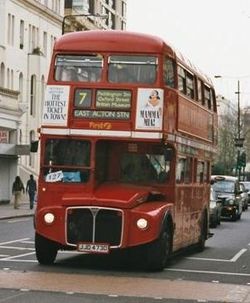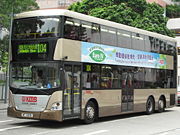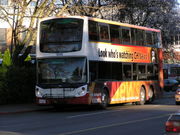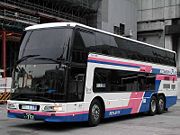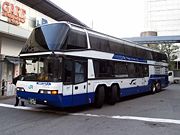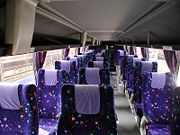Double-decker bus
2008/9 Schools Wikipedia Selection. Related subjects: Road transport
A double-decker bus is a bus that has two levels. While double-decker long-distance coaches are in widespread use around the world, double-decker city buses are less common. Double-decker buses are popular in some European cities and in some parts of Asia, usually in former British colonies. Many towns around the world have a few that specialise in short sight-seeing tours for tourists for, as William Gladstone observed, "the way to see London is from the top of a 'bus" (Gladstone was referring to London's once ubiquitous double-deck horse drawn omnibuses, rather than a motor bus).
Locations
Cities listed here use double-decker buses as part of their regular mass transit fleet. Cities with only tourist and sightseeing double-decker buses are excluded.
United Kingdom
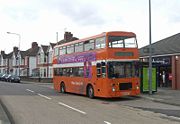
Double-decker buses are in common use throughout the United Kingdom, typically seating between 60 and 80 passengers and have become a symbolic image of the country in particular the use of the red double decker buses in London. They are between 9.5 and 10.9 metres in length and are useful as a means of carrying large numbers of passengers without exceeding legal limits on vehicle length.
A particularly iconic example was the Routemaster bus, which had been a staple of the public transport network in London for nearly half a century following its introduction in 1956. Because of cited difficulties accommodating disabled passengers, the last remaining examples in use finally retired in 2005, although Transport for London has established two "heritage routes", which will continue using Routemasters (Selected parts of routes 9 & 15) .
Ireland
The majority of buses operated in and around Greater Dublin by Dublin Bus are double-deckers. There are 1,125 double-decker buses (2nd after London) in the fleet of 1,199.
Sri Lanka
In the 1950s, double-decker buses of the South Western Bus Company plied on the Galle Road in Colombo, Sri Lanka. These were taken over by the Ceylon Transport Board (CTB) when all bus services were nationalised in 1958. In the 1960s, large numbers of second-hand double decker buses of the RT, RTL and RTW classes were imported by the CTB from London Transport and ran in their original red livery, but with the CTB logo painted on the sides. These buses were phased out beginning in the mid-1970s, but a handful still run in the Greater Colombo area. Later, around 1985, 40 ex-London Routemaster entered service. One Routemaster bus is run by the Sirasa TV and radio station. In 2005 a new batch of double decker buses were imported by the Sri Lanka Transport Board, as the reconstituted CTB is known, which run mainly on the Galle Road in Colombo.
Hong Kong
Double-decker buses were first introduced in Hong Kong in 1949 by Kowloon Motor Bus. They have become very popular since then, and they are currently found in large numbers among the fleets of the territory's major bus operators (see below). By law, double-decker buses in Hong Kong are limited to a length of 12 metres. Today, there are more than 5,000 double-decker buses running in Hong Kong. Most of them are air-con.
Singapore
In October 1953, a single AEC Regent III double-decker from the fleet of General Transport Company, Kuala Lumpur (KL), was sent to Singapore for demonstration. It was used on service by the Singapore Traction Company for two weeks. After that, it was inspected by two other bus companies and then sent back to KL. However, no orders for double-deckers were to ensue at this point in time.
Singapore Bus Service (SBS, now known as SBS Transit), the current operator of double-decker buses in Singapore, launched their first double-decker bus service on 13 June 1977 with 20 Leyland Atlanteans. This time, the double-decker buses were here to stay and the fleet grew steadily, with the further introduction of the Mercedes-Benz O305 and the Leyland Olympian. The first air-conditioned double-decker bus, named the "Superbus" in recognition of its record-breaking 12m length, was launched in 1993. The first stepless, ultra low floor "Superbus" was launched in 1999. Wheelchair accessible buses began to be introduced in 2006. Today, SBS Transit has a fleet of over 900 double-decker buses, most of which are air-conditioned.
Canada
In 2000, Victoria, British Columbia became the first city in North America to use modern double decker buses in its public transit system. These buses were imported from the United Kingdom and operated by BC Transit and the Victoria Regional Transit System, these buses have proven to be very popular amongst both locals and tourists. The buses are mainly used on routes that go from downtown to the suburbs, including the Victoria International Airport and the BC Ferries terminal near Sidney, B.C. They can also be found on routes that head to the University of Victoria and the Western Communities. In June/July 2006, double-decker bus similar to those in Victoria was being tested in Ottawa, Ontario. In December 2007, Chairman of the Victoria Regional Transit Commission Don Amos announced the purchase of 16 new double-decker buses for the region, worth an estimated $12.8 million CDN. The buses are expected to be in service the summer of 2008.
GO Transit in Toronto will start operating 12 Alexander Dennis Enviro 500 double decker buses in 2008 and 10 more in 2009.
Japan
By Japanese law, vehicles are confined to maximum 3.8 meters height and 12 meters length. Japanese double-decker buses are mainly used for inter-city highway buses (i.e., motor coaches), city tours and charter buses. In 1960, Kinki Sharyo and Hino Motors manufactured the first original double-decker bus "Vista Coach" for Kinki Nippon Railway (Kintetsu).
In 1979, Chuo Kotsu, a chartered bus operator in Osaka, imported the Neoplan Skyliner, and made double-decker buses more popular. Skyliner and the other imported buses: Van Hool Astromega TD824, Drögmöller E440 Meteor and a few MAN coaches inspired Japanese bus manufactures, who developed 3 domestic models in the middle of the 1980s: " Nissan Diesel Space Dream" , " Hino Grand View" and " Mitsubishi Fuso Aero King" . They did not, however, sell very well as the ceiling was only 1.7 meters high. Nevertheless, Aero King was sold for 22 years, but, being unable to meet exhaust gas emission and safety levels, production stopped in 2005.
In 1982, Toei Bus operated Skyliners in Tokyo, between Asakusa and Ueno to 2001. And Joban Kotsu operated Skyliners in a trans-Fukushima route: between Iwaki and Aizu-Wakamatsu via Koriyama from 1983 to 1996.
Since the 1990s, JR Buses started to use Aero King for an overnight inter-city highway bus service named "Dream-go." The first Aero King in Dream-go, operated to "Fuku Fuku Tokyo" between Tokyo and Shimonoseki, Yamaguchi with Sanden Kotsu (which was replaced with a "super high-decker" coach in middle of the 1990s, "Fuku Fuku Tokyo," and finally stopped in 2006).
Japanese overnight highway buses are mainly equipped with a 3-line, two-aisle (1+1+1) seat configuration with reclining seats. When this configuration is used on an ordinary coach, it has 28, 29 or 31 seats. When this configuration is used on a double-decker bus, it has 36 or 40 seats: the vehicle's price and capacity increase while operating cost decreases.
JR Bus group mainly uses Aero King, Skyliner and a few Jonckheere Monaco (equipped with Nissan Diesel engine) for inter-city highway bus operations between Kanto (near Tokyo) and Kansai (near Osaka), which is named "Dream-go" (overnight express) and "Hiru-tokkyu" (Daytime Express). The other bus operators, inspired by "Dream-go", increased use of the Aero King for overnight inter-city bus service.
JR Bus Kanto imported 4 Neoplan Megaliner N128/4, leasing 2 to an operating partner (from 2003 to 2006, Kanto Railway, since 2006 Nishinihon JR Bus). The Megaliner is 15 meters long and has 84 seats (with 2+2 configuration), and is operated on an inter-city highway route between Tokyo and Tsukuba, Ibaraki from 2002 to 2005. The Megaliner has also been converted for a low-price overnight highway bus service between Tokyo and Osaka called "Seishun Mega Dream-go," with special authorization.
Germany
Double decker buses in Berlin are operated by Berliner Verkehrsbetriebe (BVG). The fleet of double decker buses in Berlin fell from 1,000 in 1992 to 450 in 2002. The models in operation in 2002 were 13.5 metres (44.3 ft) long and held around 95 passengers. The replacements, which are supplied by Neoman, are 1.8 metres (5.9 ft) longer. The new buses are able to hold 128 passengers.
China
Several cities in China have double deckers in regular use on certain crowded lines, while some have a few double deck buses in use on one, or a couple of, lines which also use single deck vehicles, e.g. Nanning on line # 704 in peak hours.
India
Bangalore is not a famous centre for double decker buses in India. Chennai's MTC has a small fleet of double-decker buses mostly in the high-density, longer distance routes. Mumbai has operated double-decker buses since 1937. They are operated by the Brihanmumbai Electric Supply and Transport Undertaking. Thiruvananthapuram, Kolkata and Hyderabad also have double decker buses. They are modelled on the London buses.
United States
In Davis, California, Unitrans, the student-run bus company of University of California, Davis, operates six double-decker buses imported from London. One of these buses has been converted to run on compressed natural gas. There was also the prototype GX-1 Scenicruiser of Greyhound, which enters from the 1st floor: The second floor contains the driver's compartment and more seats.
Citizens Area Transit, the transit authority in the Las Vegas, Nevada area, introduced a fleet of double-deckers to serve the Las Vegas Strip route in October 2005. The route is branded as " The Deuce".
In Snohomish County, Washington, Community Transit operates one Enviro 500 double-decker bus, which rotates among various commuter routes between Snohomish County and Seattle.
Also, in the United States, a private operator, Megabus, run by Coach USA, employs double-decker buses on its busier intercity routes.
Turkey
The IETT (Istanbul public transit system) runs 89 double-decker buses on longer-distance routes, most notably commuter buses crossing the Bosphorus Bridge linking the European and the Asian sides of the city. Double-decker buses are also used on routes to and from Taksim Square to far-flung western suburbs such as Büyükçekmece and Bahcesehir.
In popular culture
In the UK, double-decker buses (9.5–10.9 m) are a common reference item for describing very large objects; for example, a blue whale is about as long as three double-decker buses. "That monarch of the road", the London bus, even has its very own song, "A Transport of Delight" (1956) by the comic duo Flanders and Swann.
Double-decker buses were used as the London-themed pricing game Bump on The Price Is Right from 1986-1992. The prices of the prizes were printed on buses and one bus was "bumped" into the Thames.
Operators of double decker buses
See list of operators of double decker buses.
Safety
Double decker buses have occasionally been involved in high profile accidents caused by collisions with low bridges, often caused by the driver being used to driving single decker buses and forgetting to allow for the extra height when driving a double decker.
